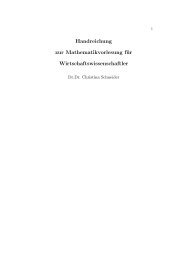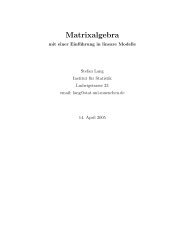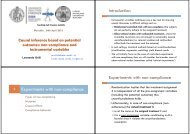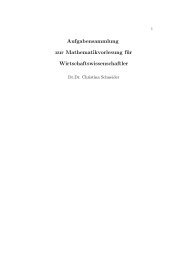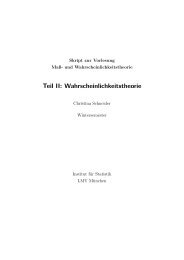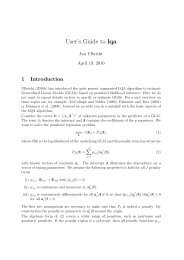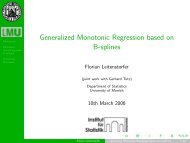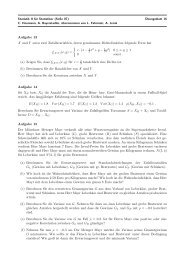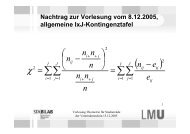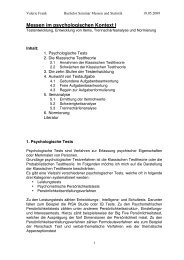Statistik II für Statistiker, Mathematiker und Informatiker (SS ... - LMU
Statistik II für Statistiker, Mathematiker und Informatiker (SS ... - LMU
Statistik II für Statistiker, Mathematiker und Informatiker (SS ... - LMU
Sie wollen auch ein ePaper? Erhöhen Sie die Reichweite Ihrer Titel.
YUMPU macht aus Druck-PDFs automatisch weboptimierte ePaper, die Google liebt.
9. Schätzen 9.1 Zufällige Stichproben<br />
9. Schätzen 9.1 Zufällige Stichproben<br />
Identisch <strong>und</strong>/oder unabhängig verteilte Stichproben<br />
• Stichprobe heißt identisch verteilt oder einfach:<br />
⇔ Stichprobenvariablen X 1 , ...,X n sind identisch wie X verteilt<br />
• Stichprobe heißt unabhängig: ⇔ X 1 , ...,X n unabhängig<br />
• X 1 ,...,X n u.i.v./i.i.d. wie X verteilt:<br />
⇔ Stichprobe identisch <strong>und</strong> unabhängig verteilt (independent and identically<br />
distributed)<br />
• Fall B: Wird Zufallsvorgang <strong>für</strong> X n-mal unabhängig wiederholt<br />
⇒ X 1 ,...,X n i.i.d. wie X ∼ F(x)<br />
• Fall A: Ob eine einfache <strong>und</strong>/oder unabhängige Stichprobe vorliegt, hängt vom<br />
Auswahlverfahren ab, siehe 9.1.2.<br />
• In jedem Fall gilt: Falls ohne Zurücklegen gezogen wird, sind X 1 , ...,X n<br />
voneinander abhängig. Bei Ziehen mit Zurücklegen: “X 1 ,...,X n unabhängig”<br />
ist sinnvolle Annahme (vgl. Urnenmodell).<br />
<strong>Statistik</strong> <strong>II</strong> <strong>für</strong> <strong>Statistik</strong>er, <strong>Mathematiker</strong> <strong>und</strong> <strong>Informatiker</strong> im <strong>SS</strong> 2007 92<br />
<strong>Statistik</strong> <strong>II</strong> <strong>für</strong> <strong>Statistik</strong>er, <strong>Mathematiker</strong> <strong>und</strong> <strong>Informatiker</strong> im <strong>SS</strong> 2007 93<br />
9. Schätzen 9.1 Zufällige Stichproben<br />
9.1.2 Rein zufällige Stichproben aus endlichen Gr<strong>und</strong>gesamtheiten<br />
Erinnerung: Nur Zufallsstichproben erlauben induktive Schlüsse mit Wahrscheinlichkeitstheorie<br />
Einige nichtzufällige Stichproben:<br />
Auswahl aufs Geratewohl, “Experten”-Auswahl, Quotenverfahren,.. .<br />
Reine (oder uneingeschränkte) Zufallsstichprobe mit Zurücklegen: ⇔<br />
• Einzelne Ziehungen sind voneinander unabhängig.<br />
• Jedes Element hat bei jeder Ziehung dieselbe Wahrscheinlichkeit 1 N gezogen<br />
zu werden.<br />
Es gilt: Eine reine Zufallsstichprobe mit Zurücklegen ist eine identisch <strong>und</strong><br />
unabhängig verteilte Stichprobe, d.h. X 1 , ...,X n i.i.d. wie X.<br />
9. Schätzen 9.1 Zufällige Stichproben<br />
Beweis: Sei F G (x) die Verteilungsfunktion von X in G.<br />
a) Zu zeigen: P(X i ≤ x) = F G (x)<br />
Sei G x = {j ∈ G : ξ j ≤ x}.<br />
{<br />
1, falls j ∈ G beim i-ten Zug gezogen wird<br />
Z ji =<br />
0, sonst<br />
P(Z ji = 1) = 1 N ,<br />
dann ist<br />
P(X i ≤ x) = ∑<br />
P(Z ji = 1) = [ Anzahl der Elemente von G x ] · 1<br />
N =<br />
j∈G x<br />
= F G (x).<br />
b) Unabhängigkeit der X i folgt aus Unabhängigkeit der Ziehung.<br />
<strong>Statistik</strong> <strong>II</strong> <strong>für</strong> <strong>Statistik</strong>er, <strong>Mathematiker</strong> <strong>und</strong> <strong>Informatiker</strong> im <strong>SS</strong> 2007 94<br />
<strong>Statistik</strong> <strong>II</strong> <strong>für</strong> <strong>Statistik</strong>er, <strong>Mathematiker</strong> <strong>und</strong> <strong>Informatiker</strong> im <strong>SS</strong> 2007 95



